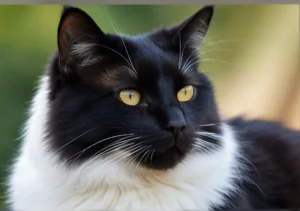Cat whiskers are a unique and intriguing feature of our feline friends. Have you ever wondered why some cat whiskers are white? Let’s explore the fascinating reason behind this curious phenomenon.
Evolutionary Purpose of Cat Whiskers
Cat whiskers may seem like just a cute feature of our feline friends, but they actually serve a vital evolutionary purpose. These specialized hairs, known as vibrissae, are super sensitive and help cats navigate their surroundings with precision. They act as a radar system for cats, helping them gauge distances, detect changes in their environment, and even sense the slightest movements.
In the wild, a cat’s whiskers are crucial for hunting and survival. They allow cats to explore dark spaces, hunt prey in low light conditions, and avoid potential dangers. So, the next time you marvel at your cat’s whiskers, remember that they are not just for show – they are a sophisticated tool that has been honed through years of evolution to help cats thrive in their environment.
Anatomy of Cat Whiskers
Cat whiskers are not just any ordinary hairs – they are specialized follicles deeply rooted in a cat’s body. These whiskers are thicker and stiffer than regular hairs, allowing them to pick up even the slightest vibrations and movements in the air.
Interestingly, cat whiskers are often white in color due to a lack of melanin, the pigment responsible for hair color. This lack of pigment makes the whiskers stand out against a cat’s fur, providing a stark contrast that helps cats easily see and interpret their surroundings. Think of them as nature’s way of highlighting a cat’s built-in sensory tool.
Here’s an additional unique insight: The white color of cat whiskers not only helps cats see them better but also serves as a warning sign to potential predators. In the animal kingdom, white is often associated with danger or toxicity, so a cat’s white whiskers may act as a visual deterrent to keep threats at bay.
Melanin and Pigmentation
Cat whiskers are typically white because they lack melanin, the pigment responsible for giving color to hair and skin. Melanin is produced by cells called melanocytes, and the amount and type of these cells in a cat’s hair follicles determine the color of their fur, whiskers included. Since whiskers are made of keratin, a protein that is naturally white, they appear colorless if not pigmented by melanin. This lack of pigment in cat whiskers is why they often stand out against their darker fur, providing a striking appearance that helps cats navigate their environment.
Age and Genetics
As cats age, their whiskers can sometimes change in color. This change is often attributed to genetics, as certain cat breeds are more prone to developing darker whiskers as they mature. Genetic factors can influence the density of melanin-producing cells in a cat’s hair follicles, which may result in a variation in whisker color over time. Additionally, the natural aging process can also play a role in the color change, as the production of melanin may decrease with age, leading to a lightening of the whiskers.
Unique Insight: Multiple factors such as genetics, age, and breed determine the color of cat whiskers, making their appearance a fascinating aspect of feline biology. Paying attention to these factors can give insight into a cat’s overall health and genetic heritage.
Remember, a cat’s whiskers serve important sensory functions, so appreciate their uniqueness and don’t be surprised if they change color over time—it’s all part of the natural beauty of our feline friends.
Environmental Factors
Cat whiskers are predominantly white due to the lack of pigment-producing cells called melanocytes. These specialized cells provide color to hair, skin, and fur, but for some reason, they seem to skip over cat whiskers. This unique trait gives our feline friends their distinctive white whiskers, contrasting with the colors of their fur. The lack of pigment in whiskers may also serve a practical purpose, helping cats sense their surroundings more effectively by providing high contrast against their environment. So, next time you see a cat with white whiskers, remember it’s not just a fashion statement; it’s nature’s way of enhancing their sensory abilities.
Common Misconceptions
Let’s debunk a common myth surrounding cat whiskers: the belief that cutting or trimming them is harmless or purely aesthetic. In reality, cat whiskers are crucial sensory tools that help cats navigate their surroundings and judge spatial distances. Trimming these sensitive whiskers can disorient and stress our feline companions, disrupting their ability to move confidently and causing undue discomfort. While whiskers do shed and grow back naturally over time, it’s essential to let them be and respect their role in a cat’s daily life. Remember, whiskers are not just for show; they’re a vital part of a cat’s sensory toolkit, and they should be treated with care and respect.
- Avoid Cutting Whiskers: Resist the temptation to trim or cut your cat’s whiskers, as it can negatively impact their sense of spatial awareness and cause unnecessary stress.
- Whiskers Serve a Purpose: Don’t underestimate the importance of cat whiskers; they play a crucial role in helping cats navigate their environment and detect potential threats.
Fun Facts About Cat Whiskers
Cat whiskers are not just for show – they serve a crucial sensory function for our feline friends. These specialized hairs are rooted deep within a cat’s body and are extremely sensitive to even the slightest touch. Here are some fun facts about cat whiskers that you may not have known:
- Whisker Superpower: Cat whiskers are so sensitive that they can pick up on even the subtlest changes in their environment, helping cats navigate and hunt with precision.
- Whiskers Come in Pairs: Cats have around 12 whiskers on each side of their face, with equal lengths on both sides to help them judge distances accurately.
- Whiskers Never Stop Growing: Just like regular hair, cat whiskers continuously grow and shed to ensure they stay at optimal length for sensory purposes.
- Mood Indicators: A cat’s whiskers can also reflect their emotional state – when a cat is curious or interested, their whiskers may be more alert and forward.
Want to learn more about your cat’s whiskers? Keep them healthy and happy with proper care and maintenance.
Care and Maintenance of Cat Whiskers
Keeping your cat’s whiskers in top-notch condition is essential for their overall well-being. Follow these tips to ensure your feline friend’s whiskers remain healthy and vibrant:
- Hands Off: Avoid trimming or plucking your cat’s whiskers – they are crucial for their sensory perception and cutting them can disorient your pet.
- Gentle Cleaning: To keep whiskers clean, gently wipe them with a soft cloth during grooming sessions to remove dirt or debris.
- Mind the Bowls: Ensure food and water bowls are wide enough for your cat’s whiskers to avoid bending or touching the sides, which can cause discomfort.
- Avoid Stress: Cats may shed more whiskers when stressed, so create a calm environment to minimize shedding.
By following these simple care tips, you can help your cat maintain healthy and vibrant whiskers, ensuring they can navigate their world with ease and grace.
Alex, a passionate animal lover, has experience in training and understanding animal behavior. As a proud pet parent to two dogs and three cats, he founded AnimalReport.net to share insights from animal experts and expand his knowledge of the animal kingdom.




